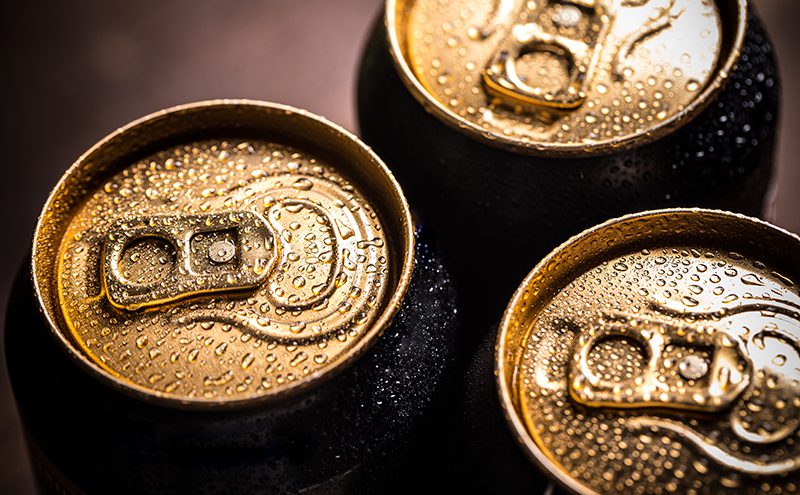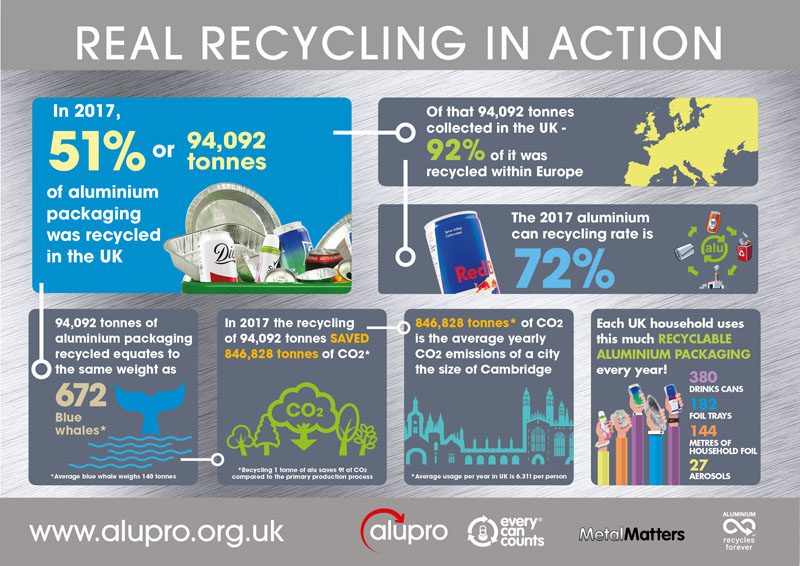
Amidst a time of gloom and foreboding about packaging waste, and the pollution it causes, one small piece of good news – a silver lining in the cloud, as it were – is that aluminium recycling is on the increase.
The recycling rate for aluminium drinks cans hit 72% in 2017 [1] (up from 70% in 2016), whilst the national recycling rate for all aluminium packaging reached 51% (up from 50% in 2016), according to a 16 April announcement from the Aluminium Packaging Recycling Organisation (Alupro)
According to packaging waste recovery data, recently released by the Environment Agency [2], aluminium packaging easily achieved its 2017 business target.
There was a 4% increase in the number of PRNs raised in 2017 compared to 2016 – 24,092 tonnes (for 2017) vs 90,095 tonnes (2016). Ultimately, the PRN numbers show that over 8,000 tonnes of aluminium PRNs were raised but not issued. As in previous years, there is evidence that some reprocessors/exporters chose not to become accredited or decided not to raise the maximum number of PRNs (that they could have done), given the resulting low PRN prices.
Alupro says this highlights why it supports reforms to the PRN system: “Our priorities are to ensure the system accurately records all the aluminium packaging collected for recycling, that consumer focussed behaviour change programmes are properly funded and that ‘real recycling’ is recognised and rewarded.”
Data also shows that 92% of the aluminium packaging collected for recycling in the UK, is recycled within Europe [3]. Alupro says this demonstrates that there is more than sufficient capacity within the EU to recycle the aluminium packaging recovered for recycling in the UK.

Commenting on the recycling rates, Alupro’s Executive Director Rick Hindley said: “It is fantastic to see aluminium packaging recycling rates continuing to increase year on year. We must continue to increase awareness and understanding of what happens to used aluminium packaging when it is recycled. Given widespread concerns regarding where our kerbside recycling ends up, and whether it is actually recycled, we believe the 92% statistic will give people the confidence that when they recycle aluminium packaging, it really is recycled – and close to home.
“Aluminium packaging has an intrinsic value. The issue is encouraging consumers to recognise aluminium packaging as an extremely cost-effective material to recycle, through education and effective communications. In the UK, developing and stimulating the existing kerbside collection infrastructure is a great starting point, but consistency is essential – the public remains confused by the differing rules across local authorities. We must help them to do the right thing and recycle.”
Alupro manages several programmes funded by metal packaging manufacturers, reprocessors and leading brands, and it says the industry believes these are making a vital contribution towards encouraging consumers to recycle more. MetalMatters focuses on improving metal capture rates in local authority recycling schemes; whilst Every Can Counts supports organisations wanting to enable people to recycle the beverage cans used outside the home.
Notes
[1] The recycling rate for aluminium beverage cans is calculated by Alupro using data supplied by the national packaging waste database and by its member companies, using methodology consistent with that used across Europe to calculate recycling rates.
http://www.metalpackagingeurope.org/
[2] https://npwd.environment-agency.gov.uk/Public/PublicSummaryData.aspx
[3] The ‘End destination’ data was obtained under a “freedom of information” request from the Environment Agency, said Alupro. 51% of aluminium packaging collected was recycled in the UK and 41% recycled in Europe.






